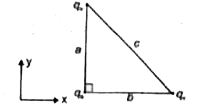Suppose that three point charges qa,qb and qc are arranged at the vertices of a right -angled triangle as shown . What is the absolute electric potential at the position of the third charge if qa=−6.0μC,qb=+4.0μC,qc=+2.0μC,a=4.0m and b=3.0 m ? Suppose that the third charge which is initially at rest is repelled to infinity by the combined electric field of the other two charges which are held fixed . What is the final kinetic energy of the third charge ?

The electric potential at P (the position of the third charge ) due to the presence of the first charge is
Va=Keqac=(9×109)(−6×10−6)(√42+32)=−1.08×104V
Likewise the electric potential due to the presence of the second charge is
Vb=Keqbb=(9×109)(4×10−6)(3)=1.20×104V.
The net potential of the third charge Vc is simply the algebraic sum of the potentials due to the others two charges taken in isolation . Thus
Vc=Va+Vb=1.20×103V
Topper's Solved these Questions
- ELECTROSTATIC POTENTIAL AND CAPACITANCE BOOK - AAKASH INSTITUTECHAPTER - ELECTROSTATIC POTENTIAL AND CAPACITANCE EXERCISE - TRY YOURSELF
110 Videos
- ELECTROSTATIC POTENTIAL AND CAPACITANCE BOOK - AAKASH INSTITUTECHAPTER - ELECTROSTATIC POTENTIAL AND CAPACITANCE EXERCISE - ASSIGNMENT (SECTION-A) Objective Type Questions (Only one answer)
47 Videos
- ELECTROMAGNETIC WAVESBOOK - AAKASH INSTITUTECHAPTER - ELECTROMAGNETIC WAVESEXERCISE - ASSIGNMENT SECTION - D Assertion-Reason Type Questions
25 Videos
- GRAVITATION BOOK - AAKASH INSTITUTECHAPTER - GRAVITATION EXERCISE - ASSIGNMENT SECTION - D (ASSERTION-REASON TYPE QUESTIONS)
16 Videos
Similar Questions
Suppose that three point charges qa,qb and qc are arranged at the vertices of a right -angled triangle as shown . What is the absolute electric potential at the position of the third charge if qa=−6.0μC,qb=+4.0μC,qc=+2.0μC,a=4.0m and b=3.0 m ? Suppose that the third charge which is initially at rest is repelled to infinity by the combined electric field of the other two charges which are held fixed . What is the final final kinetic energy of the third charge ?

View SolutionSuppose that three point charges qa,qb and qc are arranged at the vertices of a right -angled triangle as shown . What is the absolute electric potential at the position of the third charge if qa=−6.0μC,qb=+4.0μC,qc=+2.0μC,a=4.0m and b=3.0 m ? Suppose that the third charge which is initially at rest is repelled to infinity by the combined electric field of the other two charges which are held fixed . What is the final kinetic energy of the third charge ?

View Solution
Knowledge Check
Three charges Q0,−q and −q are placed at the vertices of an isosceles right angle triangle as in the figure. The net electrostatic potential energy is zero if Q 0 is equal to :
 Aq4Bq2√2C√2qD+q
Aq4Bq2√2C√2qD+qCharges +q−4q and +2q are arranged at the corners of an equilatoral triangle of side 0.15m.If the q=1μC their mutual potential energy is
A0.4JB0.5JC0.6JD0.8J
Suppose that three point charges, qa,qbandqc are arranged at the vertices of a right-angled triangle, as shown. What is the absolute potential at the position of the third charge, if qa=6.0μC,qb=+4.0μC,qc=+2.0μC,a=4.0mandb=3.0m ?

View SolutionSuppose that three point charges, qa,qbandqc are arranged at the vertices of a right-angled triangle, as shown. What is the absolute potential at the position of the third charge, if qa=−6.0μC,qb=+4.0μC,qc=+2.0μC,a=4.0mandb=3.0m ?

View SolutionThree charges Q0,−q and −q are placed at the vertices of an isosceles right angle triangle as in the figure. The net electrostatic potential energy is zero if Q 0 is equal to :

View SolutionThree charges +q,2qand−4q are placed on the three vertices of an equale-laterail triangle of each side0⋅1m. Calculate electrostatic potential energy of the system, take q=10−7C
View SolutionThe point charges q1=1μC,q2=−2μC and q3=3μC are placed at (1m,0,0),(0,2m,0) and (0,0,3m) respectively. Find the electric potential at origin.
View SolutionTwo point charges qA=3μCandqB=−3μC are located 20cm apart in vacuum. What is the electric field at the mid point of the line joining the two charges.

View Solution
